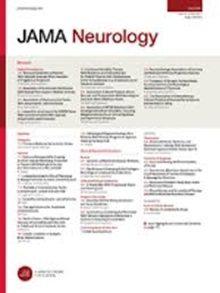Sex Differences in Mortality and Health Care Utilization After Dementia Diagnosis.
IF 21.3
1区 医学
Q1 CLINICAL NEUROLOGY
引用次数: 0
Abstract
Importance Sex differences may contribute to disparities in dementia outcomes. Objective To understand the association between sex and mortality and health care services use after dementia diagnosis. Design, Setting, and Participants This nationwide cohort study used Medicare enrollment data and took place from 2014 to 2021 with up to 8 years of follow-up. Analysis was performed from April 2024 to April 2025. This study included 5 721 711 patients 65 years or older with International Statistical Classification of Diseases and Related Health Problems, Tenth Revision diagnosis codes for dementia with at least 1 year of prior fee-for-service Medicare enrollment. Exposures Sex, determined from Medicare enrollment data, derived from Social Security Administration records. Main Outcomes and Measures The primary outcome was hazard of all-cause mortality, estimated with Cox proportional hazard regression. Secondary outcomes included hazards of use of common health care services, such as all-cause hospitalizations, skilled nursing facility stays, receipt of neuroimaging services, and physical/occupational therapy. Results A total of 5 721 711 patients (3 302 579 female and 2 419 132 male) with incident dementia between 2014 and 2021 were included in the study. Female patients had lower crude 1-year mortality rates (21.8% vs 27.2% for male patients; P < .001) and lower rates of all-cause hospitalizations (46.9% vs 50.5%; P < .001). The unadjusted hazard of death associated with male sex was 1.30 (95% CI, 1.29-1.31; P < .001). After adjustment for age, race and ethnicity, Medicaid dual eligibility, medical comorbidity burden, and access to health care resources, the association was modestly attenuated (adjusted hazard ratio, 1.24; 95% CI, 1.23-1.26; P < .001). Similarly, the unadjusted hazard ratio of all-cause hospitalization associated with male sex was 1.13 (95% CI, 1.12-1.14; P < .001); the adjusted hazard ratio was 1.08 (95% CI, 1.08-1.09; P < .001). Male patients also had increased hazards of hospice stay, neuroimaging services, and hospitalization for neurodegenerative disease diagnosis or behavioral disturbance. Conclusions and Relevance In this study, male patients with dementia had higher mortality rates and higher use of many health care services, especially hospital stays, than comparable female patients. Strategies to slow mortality and decrease health care use among male patients with dementia may be particularly impactful in limiting the burden of dementia. Given higher incidence of dementia among women, a focus on efforts to prevent dementia is necessary to achieve population-level health equity in dementia-attributable mortality by sex.痴呆诊断后死亡率和医疗保健利用的性别差异
性别差异可能导致痴呆结果的差异。目的了解性别与痴呆诊断后死亡率和医疗服务使用的关系。设计、环境和参与者:这项全国性队列研究使用了2014年至2021年的医疗保险登记数据,随访时间长达8年。分析时间为2024年4月至2025年4月。本研究纳入5名 721 711名65岁或以上的患者,他们患有国际疾病和相关健康问题统计分类第十版痴呆诊断代码,并且至少有1年的医疗保险登记。暴露性别,根据医疗保险登记数据确定,来源于社会保障局记录。主要结局和测量方法主要结局是全因死亡率风险,用Cox比例风险回归估计。次要结局包括使用普通卫生保健服务的危害,如全因住院、专业护理机构住院、接受神经成像服务和物理/职业治疗。结果2014 - 2021年共纳入5例 721 711例痴呆患者(3 302 579例女性,2 419 132例男性)。女性患者的1年粗死亡率较低(21.8% vs 27.2%);P < 0.001),全因住院率较低(46.9% vs 50.5%;p < 0.001)。与男性相关的未校正死亡风险为1.30 (95% CI, 1.29-1.31;p < 0.001)。在调整了年龄、种族和民族、医疗补助双重资格、医疗合并症负担和卫生保健资源的可及性后,这种关联略有减弱(调整后的风险比为1.24;95% ci, 1.23-1.26;p < 0.001)。同样,与男性相关的全因住院的未调整风险比为1.13 (95% CI, 1.12-1.14;p < .001);调整后的风险比为1.08 (95% CI, 1.08-1.09;p < 0.001)。男性患者接受临终关怀、神经影像学服务、因神经退行性疾病诊断或行为障碍住院的风险也增加。在这项研究中,男性痴呆症患者的死亡率和许多医疗保健服务的使用率,特别是住院时间,都高于女性患者。减缓男性痴呆症患者死亡率和减少医疗保健使用的策略可能在限制痴呆症负担方面特别有效。鉴于妇女痴呆症发病率较高,有必要把重点放在预防痴呆症的努力上,以实现按性别分列的痴呆症导致的死亡率在人口层面的健康平等。
本文章由计算机程序翻译,如有差异,请以英文原文为准。
求助全文
约1分钟内获得全文
求助全文
来源期刊

JAMA neurology
CLINICAL NEUROLOGY-
CiteScore
41.90
自引率
1.70%
发文量
250
期刊介绍:
JAMA Neurology is an international peer-reviewed journal for physicians caring for people with neurologic disorders and those interested in the structure and function of the normal and diseased nervous system. The Archives of Neurology & Psychiatry began publication in 1919 and, in 1959, became 2 separate journals: Archives of Neurology and Archives of General Psychiatry. In 2013, their names changed to JAMA Neurology and JAMA Psychiatry, respectively. JAMA Neurology is a member of the JAMA Network, a consortium of peer-reviewed, general medical and specialty publications.
 求助内容:
求助内容: 应助结果提醒方式:
应助结果提醒方式:


